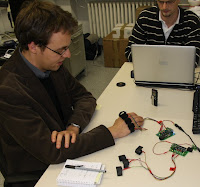One Ez430-F2013 for each student in DSD
Enrico Rukzio visits our Lab
 Enrico Rukzio (my first PhD from Munich, now lecturer in Lancaster) visited our Lab. He was make a small tour of Germany (Münster, Essen, Oldenburg). In the user interface engineering class Enrico showed some on his current work on mobile interaction, in particular mobile projectors and NFC tags. After the presentation we wondered how long it will take till kids on the train will play with mobile projections 😉
Enrico Rukzio (my first PhD from Munich, now lecturer in Lancaster) visited our Lab. He was make a small tour of Germany (Münster, Essen, Oldenburg). In the user interface engineering class Enrico showed some on his current work on mobile interaction, in particular mobile projectors and NFC tags. After the presentation we wondered how long it will take till kids on the train will play with mobile projections 😉
Biometrics will come, who will care about privacy
Will we have face-2-face PC meetings in the future?
Christmas market in Essen
 Going to Christmas market is in Germany a tradition – and obviously our group went, too 😉
Going to Christmas market is in Germany a tradition – and obviously our group went, too 😉
It is interesting that most of us had time for this „appointment“ with only two days notice – usually it takes us weeks to find a date for a meeting and so far we did not find a date for a strategy meeting in the near future. Perhaps offering Glühwein (that is what you drink at Christmas markets) would help…
The quality of photos taken with a mobile phone is in difficult context (e.g. night, lights around) still not satisfactory (even with 5MP, downscaling, and image enhancing).
Known route – driving your car in mental auto-pilot?
Exporting your cars information to the mobile phone
Information vs. Mobility, Percom PC meeting in New York
 PS: it is amazing how many possiblities there are to serve coffee (and this is probably not one of the most environment friendly)
PS: it is amazing how many possiblities there are to serve coffee (and this is probably not one of the most environment friendly)










